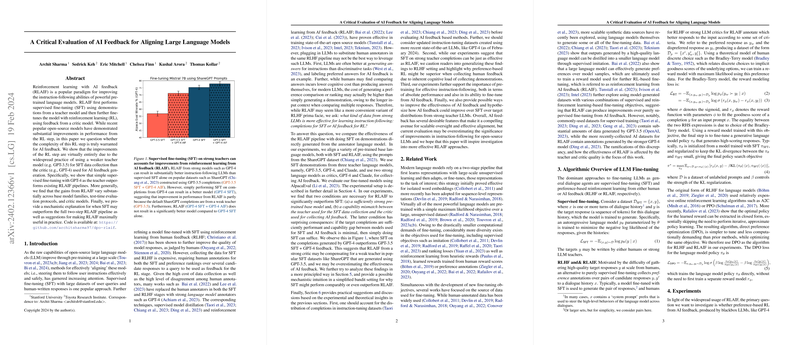Evaluating the Efficacy of AI Feedback in LLM Alignment
Introduction
The alignment of LLMs with human intentions is a pivotal area of research, given the expanding capabilities of these models. A popular approach, Reinforcement Learning with AI Feedback (RLAIF), aims to enhance the instruction-following capabilities of LLMs. This method utilizes Supervised Fine-Tuning (SFT) on demonstrations from a "teacher" model, followed by reinforcement learning fine-tuning using feedback from a "critic" model. Despite the initial successes reported in leveraging RLAIF for LLM alignment, this paper presents a critical evaluation, proposing that the performance improvements attributed to RLAIF might be substantially overestimated due to methodological oversights.
Methodological Insights
The paper meticulously dissects the RLAIF process, attesting that the observed enhancements could primarily stem from the utilization of stronger critic models for AI feedback generation, compared to weaker teacher models used for SFT data collection. Significantly, it unveils that employing a strong teacher model (e.g., GPT-4) for SFT surpasses or equals the performance gains credited to the RLAIF pipeline. This observation suggests a reconsideration of RLAIF's advantage in the alignment of LLMs.
Key Findings
- Inefficacy of RLAIF Over SFT: Contrary to widespread claims, simple SFT with a strong teacher model, like GPT-4, can outperform the RLAIF approach. This is particularly evident when the base model and critic model exhibit minimal capability gap.
- Variability Across Model Families: The effectiveness of RLAIF is not universally applicable, showing variability across different base models, evaluation protocols, and critic models. This highlights the need for a nuanced understanding of when and how RLAIF may offer genuine improvements.
- Mechanistic Explanation: A possible explanation for SFT's comparable or superior performance is the quality of generated completions and the inherent capability of the base models. The paper suggests that current LLMs might not efficiently leverage AI feedback for substantial enhancement over SFT, especially if the SFT utilizes a strong teacher model.
Implications and Future Directions
This paper's findings raise critical questions about the prevailing assumptions surrounding the utility of AI feedback in LLM alignment. It encourages a re-evaluation of the reliance on RLAIF, advocating for:
- Enhanced Instruction-Tuning Datasets: A call for the continuous updating and improvement of instruction-tuning datasets, ensuring they are distilled from state-of-the-art teacher models to maximize the potential gains from SFT.
- Careful Consideration of AI Feedback: The paper suggests a dynamic balance in leveraging AI feedback, urging for a reassessment of its role vis-à-vis direct SFT approaches, especially considering the operational and cost implications.
- Further Research on Base Model Responsiveness: There is a signal for the need to explore base models' intrinsic ability to benefit from reinforcement learning tweaks and the quality of feedback generation, potentially leading to more sophisticated alignment methodologies.
Conclusion
By critically examining the prevailing methodologies in LLM alignment, specifically the RLAIF approach, this paper catalyzes a pivotal discussion on the effectiveness and efficiency of leveraging AI feedback. The nuanced findings underscore the necessity of rigor in evaluating the true benefits of AI-driven fine-tuning processes, prompting a reassessment of how best to advance the field of LLM alignment. Future research in this arena must carefully navigate these insights, ensuring that enhancements in LLM instruction-following capacities are both genuine and practically achievable.
